Enhancing Disaster Situation Awareness Through Multimodal Social Media Data: Evidence from Typhoon Haikui
Abstract
:1. Introduction
- In terms of fine-grained temporal information extraction, traditional remote sensing imagery has long revisit cycles and coarse temporal resolution, making continuous monitoring challenging. In contrast, Sina Weibo social media data can achieve minute-level temporal resolution, enabling minute-by-minute situational awareness of disasters, thereby significantly improving temporal granularity.
- For the fine-grained spatial information extraction, conventional observation stations are costly to construct and limited in number, making it difficult to capture spatial heterogeneity. By extracting disaster damage characteristics from real images and utilizing multi-dimensional data fields such as text, images, and geolocation, this approach identifies damage locations that are often missed by disaster relief agencies. This improves spatial resolution, providing real-time, on-site information about disaster damage, and helping decision-makers gain a more comprehensive understanding of the extent and severity of the disaster-affected areas.
- For the coarse-grained spatiotemporal information extraction, the proposed integrated method offers a detailed reflection of the dynamic evolution of typhoon disaster situations. It explores the spatiotemporal characteristics of the pre-disaster, during-disaster, and post-disaster stages, providing an objective and spatiotemporal depiction of the typhoon’s development, key inflection points, and the impact of disaster damage.
2. Methodology
2.1. Overview
- Step 1: Data Collection and Preprocessing—Collect multimodal data from Sina Weibo related to Typhoon Haikui in Fuzhou and filter images related to disaster damage using the MobileNetV3 binary classifier.
- Step 2: Multimodal Social Sensing Information Extraction—Extract disaster-related information by segmenting and classifying images with DeepLabV3+ and analyzing text with the ERNIE model to identify geographic locations and disaster categories.
- Step 3: Spatiotemporal Heterogeneity of Disaster and Driver Analysis—Visualize the spatiotemporal distribution of disaster information, conduct disaster hotspot analysis, and apply the Geodetector to explore spatial heterogeneity and driving factors of disaster hotspots.
2.2. Data Collection and Preprocessing
2.2.1. Weibo Multimodal Data Acquisition
2.2.2. Weibo Image Deduplication
2.2.3. Disaster-Related Image Filtering Using MobileNetV3
2.3. Extract Multimodal Social Sensing Disaster Information
2.3.1. Disaster Image Segmentation Using Deeplabv3+
2.3.2. ERNIE-Based Extraction of Location and Damage Information
2.4. Spatiotemporal Heterogeneity of Disaster and Its Driving Factors
2.4.1. Disaster Hotspot Analysis
2.4.2. Analyzing Disaster Drivers with Geodetector
3. Case Validation: Typhoon Haikui
3.1. Spatiotemporal Situation Analysis of Haikui
3.2. Impact Awareness
3.2.1. Social Impact
3.2.2. Traffic Impact
3.2.3. Water and Electricity Impact
3.3. Spatial Heterogeneity and Attribution Analysis
4. Conclusions
4.1. Significance and Contributions
4.2. Limitations and Future Research
Author Contributions
Funding
Institutional Review Board Statement
Informed Consent Statement
Data Availability Statement
Conflicts of Interest
References
- Cheng, C.; Pei, T.; Liu, Y. Practice and Method Exploration of Natural Disaster Situation Awareness in the New Era. Acta Geogr. Sin. 2023, 78, 548–557. [Google Scholar]
- Goodchild, M.F. Citizens as Sensors: The World of Volunteered Geography. GeoJournal 2007, 69, 211–221. [Google Scholar] [CrossRef]
- Tzavella, K.; Fekete, A.; Friedrich, F. Opportunities Provided by Geographic Information Systems and Volunteered Geographic Information for a Timely Emergency Response during Flood Events in Cologne, Germany. Nat. Hazards 2018, 91, 29–57. [Google Scholar] [CrossRef]
- Yan, Z.; Guo, X.; Zhao, Z.; Tang, L. Achieving Fine-Grained Urban Flood Perception and Spatio-Temporal Evolution Analysis Based on Social Media. Sustain. Cities Soc. 2024, 101, 105077. [Google Scholar] [CrossRef]
- Lin, L.; Tang, C.; Liang, Q.; Wu, Z.; Wang, X.; Zhao, S. Rapid Urban Flood Risk Mapping for Data-Scarce Environments Using Social Sensing and Region-Stable Deep Neural Network. J. Hydrol. 2023, 617, 128758. [Google Scholar] [CrossRef]
- Rajput, A.A.; Li, Q.; Zhang, C.; Mostafavi, A. Temporal Network Analysis of Inter-Organizational Communications on Social Media during Disasters: A Study of Hurricane Harvey in Houston. Int. J. Disaster Risk Reduct. 2020, 46, 101622. [Google Scholar] [CrossRef]
- Feng, Y.; Huang, X.; Sester, M. Extraction and Analysis of Natural Disaster-Related VGI from Social Media: Review, Opportunities and Challenges. Int. J. Geogr. Inf. Sci. 2022, 36, 1275–1316. [Google Scholar] [CrossRef]
- Wu, K.; Wu, J.; Ye, M. Application of Social Media Data in Natural Disaster Emergency Management: A Review. Prog. Geogr. 2020, 39, 1412–1422. [Google Scholar] [CrossRef]
- Daly, S.; Thom, J.A. Mining and Classifying Image Posts on Social Media to Analyse Fires. In Proceedings of the ISCRAM 2016 Conference, Rio de Janeiro, Brazil, 22–25 May 2016; pp. 1–14. [Google Scholar]
- Sit, M.A.; Koylu, C.; Demir, I. Identifying Disaster-Related Tweets and Their Semantic, Spatial and Temporal Context Using Deep Learning, Natural Language Processing and Spatial Analysis: A Case Study of Hurricane Irma. In Social Sensing and Big Data Computing for Disaster Management; Routledge: London, UK, 2020; pp. 8–32. [Google Scholar]
- Wu, D.; Cui, Y. Disaster Early Warning and Damage Assessment Analysis Using Social Media Data and Geo-Location Information. Decis. Support Syst. 2018, 111, 48–59. [Google Scholar] [CrossRef]
- Wang, R.-Q.; Mao, H.; Wang, Y.; Rae, C.; Shaw, W. Hyper-Resolution Monitoring of Urban Flooding with Social Media and Crowdsourcing Data. Comput. Geosci. 2018, 111, 139–147. [Google Scholar] [CrossRef]
- Alam, F.; Sajjad, H.; Imran, M.; Ofli, F. CrisisBench: Benchmarking Crisis-Related Social Media Datasets for Humanitarian Information Processing. arXiv 2021, arXiv:2004.06774. [Google Scholar] [CrossRef]
- Wang, Y.; Ruan, S.; Wang, T.; Qiao, M. Rapid Estimation of an Earthquake Impact Area Using a Spatial Logistic Growth Model Based on Social Media Data. In Social Sensing and Big Data Computing for Disaster Management; Routledge: London, UK, 2020; pp. 68–87. [Google Scholar]
- Yang, T.; Xie, J.; Li, G.; Mou, N.; Li, Z.; Tian, C.; Zhao, J. Social Media Big Data Mining and Spatio-Temporal Analysis on Public Emotions for Disaster Mitigation. ISPRS Int. J. Geo-Inf. 2019, 8, 29. [Google Scholar] [CrossRef]
- Murthy, D.; Longwell, S.A. Twitter and Disasters: The Uses of Twitter during the 2010 Pakistan Floods. Inf. Commun. Soc. 2013, 16, 837–855. [Google Scholar] [CrossRef]
- Xiao, Y.; Li, B.; Gong, Z. Real-Time Identification of Urban Rainstorm Waterlogging Disasters Based on Weibo Big Data. Nat. Hazards 2018, 94, 833–842. [Google Scholar] [CrossRef]
- Mikolov, T. Efficient Estimation of Word Representations in Vector Space. arXiv 2013, arXiv:1301.3781. [Google Scholar]
- Huang, X.; Li, Z.; Wang, C.; Ning, H. Identifying Disaster Related Social Media for Rapid Response: A Visual-Textual Fused CNN Architecture. Int. J. Digit. Earth 2020, 13, 1017–1039. [Google Scholar] [CrossRef]
- Mao, H.; Thakur, G.; Sparks, K.; Sanyal, J.; Bhaduri, B. Mapping Near-Real-Time Power Outages from Social Media. In Social Sensing and Big Data Computing for Disaster Management; Routledge: London, UK, 2020; pp. 88–102. [Google Scholar]
- Jain, P.; Ross, R.; Schoen-Phelan, B. Estimating Distributed Representation Performance in Disaster-Related Social Media Classification. In Proceedings of the 2019 IEEE/ACM International Conference on Advances in Social Networks Analysis and Mining (ASONAM), Vancouver, BC, Canada, 27–30 August 2019; pp. 723–727. [Google Scholar]
- Jing, M.; Scotney, B.W.; Coleman, S.A.; McGinnity, M.T. The Application of Social Media Image Analysis to an Emergency Management System. In Proceedings of the IEEE 11th International Conference on Availability, Reliability and Security (ARES), Salzburg, Austria, 31 August–2 September 2016; pp. 805–810. [Google Scholar]
- Ahmad, S.; Ahmad, K.; Ahmad, N.; Conci, N. Convolutional Neural Networks for Disaster Images Retrieval. In Proceedings of the MediaEval 2017 Workshop, Dublin, Ireland, 13–15 September 2017. [Google Scholar]
- Ofli, F.; Alam, F.; Imran, M. Analysis of Social Media Data Using Multimodal Deep Learning for Disaster Response. arXiv 2020, arXiv:2004.11838. [Google Scholar]
- Ahmad, Z.; Jindal, R.; Mukuntha, N.; Ekbal, A.; Bhattacharyya, P. Multi-Modality Helps in Crisis Management: An Attention-Based Deep Learning Approach of Leveraging Text for Image Classification. Expert Syst. Appl. 2022, 195, 116626. [Google Scholar] [CrossRef]
- Wu, Y.; Chen, Y.; Zhang, R.; Cui, Z.; Liu, X.; Zhang, J.; Wang, M.; Wu, Y. A Spatial Information Extraction Method Based on Multi-Modal Social Media Data: A Case Study on Urban Inundation. ISPRS Int. J. Geo-Inf. 2023, 12, 368. [Google Scholar] [CrossRef]
- Lue, E.; Wilson, J.P.; Curtis, A. Conducting Disaster Damage Assessments with Spatial Video, Experts, and Citizens. Appl. Geogr. 2014, 52, 46–54. [Google Scholar] [CrossRef]
- Alam, F.; Ofli, F.; Imran, M. Descriptive and Visual Summaries of Disaster Events Using Artificial Intelligence Techniques: Case Studies of Hurricanes Harvey, Irma, and Maria. Behav. Inf. Technol. 2020, 39, 288–318. [Google Scholar] [CrossRef]
- Nguyen, D.T.; Ofli, F.; Imran, M.; Mitra, P. Damage Assessment from Social Media Imagery Data during Disasters. In Proceedings of the 2017 IEEE/ACM International Conference on Advances in Social Networks Analysis and Mining (ASONAM), Sydney, NSW, Australia, 31 July–3 August 2017; pp. 569–576. [Google Scholar]
- Mouzannar, H.; Rizk, Y.; Awad, M. Damage Identification in Social Media Posts Using Multimodal Deep Learning. In Proceedings of the 15th International Conference on Information Systems for Crisis Response and Management, Rochester, NY, USA, 20–23 May 2018. [Google Scholar]
- Imran, M.; Alam, F.; Qazi, U.; Peterson, S.; Ofli, F. Rapid Damage Assessment Using Social Media Images by Combining Human and Machine Intelligence. arXiv 2020, arXiv:2004.06675. [Google Scholar]
- Dou, M.; Wang, Y.; Gu, Y.; Dong, S.; Qiao, M.; Deng, Y. Disaster Damage Assessment Based on Fine-Grained Topics in Social Media. Comput. Geosci. 2021, 156, 104893. [Google Scholar] [CrossRef]
- Chen, Z.; Lim, S. Social Media Data-Based Typhoon Disaster Assessment. Int. J. Disaster Risk Reduct. 2021, 64, 102482. [Google Scholar] [CrossRef]
- Li, S.; Wang, Y.; Huang, H.; Huang, L.; Chen, Y. Study on Typhoon Disaster Assessment by Mining Data from Social Media Based on Artificial Neural Network. Nat. Hazards 2023, 116, 2069–2089. [Google Scholar] [CrossRef]
- Malik, M.; Lamba, H.; Nakos, C.; Pfeffer, J. Population Bias in Geotagged Tweets. In Standards and Practices in Large-Scale Social Media Research; Technical Report WS-15-18; AAAI Press: Washington, DC, USA, 2015; Volume 9, pp. 18–27. [Google Scholar]
- Chae, J.; Thom, D.; Jang, Y.; Kim, S.; Ertl, T.; Ebert, D.S. Public Behavior Response Analysis in Disaster Events Utilizing Visual Analytics of Microblog Data. Comput. Graph. 2014, 38, 51–60. [Google Scholar] [CrossRef]
- Bakillah, M.; Li, R.-Y.; Liang, S.H. Geo-Located Community Detection in Twitter with Enhanced Fast-Greedy Optimization of Modularity: The Case Study of Typhoon Haiyan. Int. J. Geogr. Inf. Sci. 2015, 29, 258–279. [Google Scholar] [CrossRef]
- Liang, C.; Lin, G.; Zhang, M.; Wang, W.; Zhang, W.; Lin, J.; Deng, C. A Study on the Effectiveness of Social Media Data in Reflecting the Spatial and Temporal Distribution of Typhoon Disasters. J. Geo-Inf. Sci. 2018, 20, 807–816. [Google Scholar]
- Alam, F.; Ofli, F.; Imran, M.; Alam, T.; Qazi, U. Deep Learning Benchmarks and Datasets for Social Media Image Classification for Disaster Response. In Proceedings of the 2020 IEEE/ACM International Conference on Advances in Social Networks Analysis and Mining (ASONAM), Hague, The Netherlands, 7–10 December 2020; pp. 151–158. [Google Scholar]
- Kersten, J.; Klan, F. What Happens Where during Disasters? A Workflow for the Multifaceted Characterization of Crisis Events Based on Twitter Data. J. Contingencies Crisis Manag. 2020, 28, 262–280. [Google Scholar] [CrossRef]
- Zhang, Q.; Xie, J.; Liu, Z.; Yang, T.; Li, Z. Hainan Wind Disaster Monitoring Dataset Based on Social Media. China Sci. Data 2019, 4. [Google Scholar]
- China Meteorological Administration. QX/T 531-2019 Technical Specification for Meteorological Disaster Investigation Meteorological Disaster Information Collection; China Meteorological Press: Beijing, China, 2019. [Google Scholar]
- Howard, A.; Sandler, M.; Chu, G.; Chen, L.; Chen, B.; Tan, M.; Wang, W.; Zhu, Y.; Pang, R.; Vasudevan, V.; et al. Searching for MobileNetV3; IEEE: Piscataway, NJ, USA, 2019; pp. 1314–1324. [Google Scholar]
- Chen, L.; Zhu, Y.; Papandreou, G.; Schroff, F.; Adam, H. Encoder-Decoder with Atrous Separable Convolution for Semantic Image Segmentation; Ferrari, V., Hebert, M., Sminchisescu, C., Weiss, Y., Eds.; Springer: Berlin/Heidelberg, Germany, 2018; Volume 11211, pp. 833–851. [Google Scholar]
- Sun, Y.; Wang, S.; Feng, S.; Ding, S.; Pang, C.; Shang, J.; Liu, J.; Chen, X.; Zhao, Y.; Lu, Y.; et al. ERNIE 3.0: Large-Scale Knowledge Enhanced Pre-Training for Language Understanding and Generation. arXiv 2021, arXiv:2107.02137. [Google Scholar]
- Wang, J.; Xu, C. Geodetector: Principle and prospective. Acta Geogr. Sin. 2017, 72, 116–134. [Google Scholar]
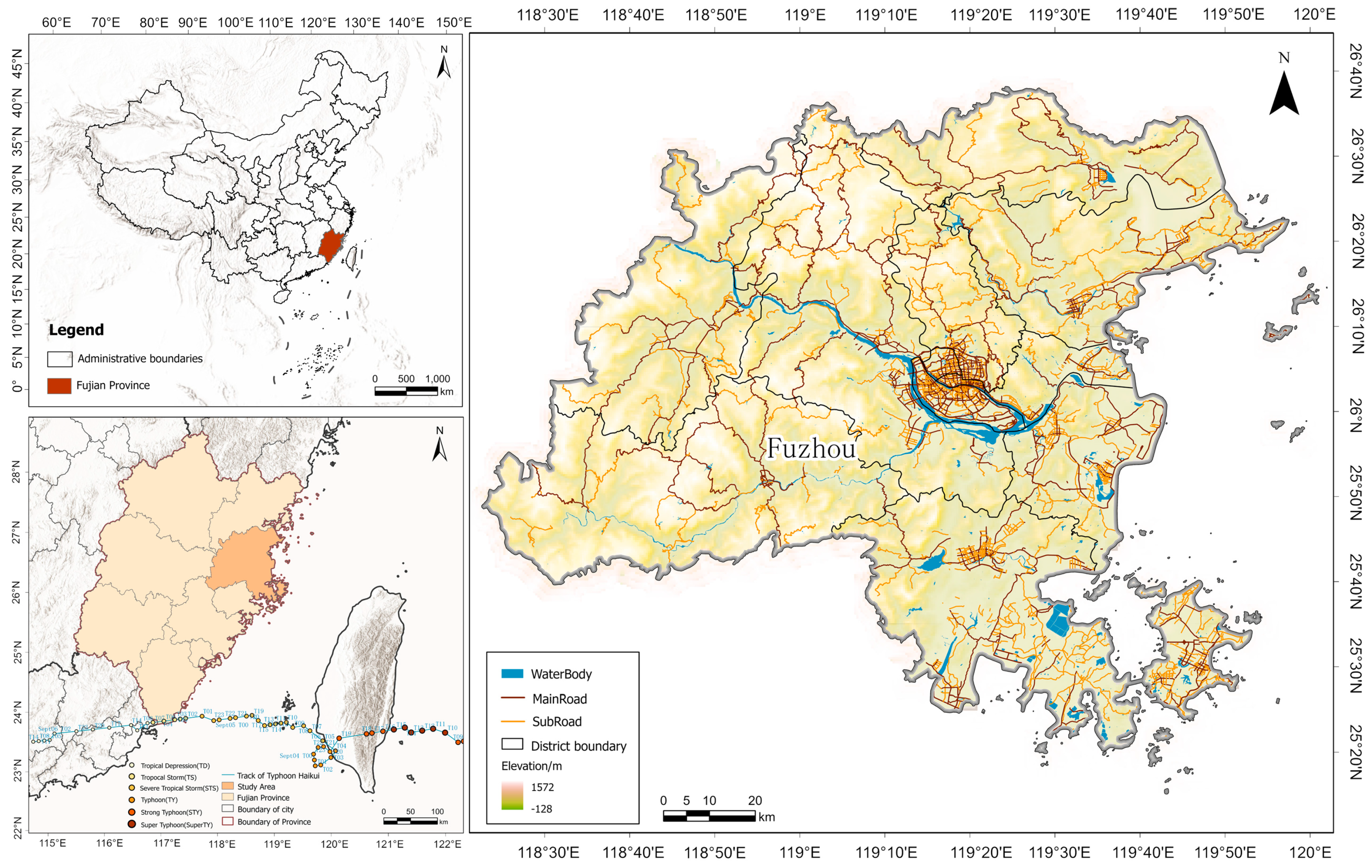

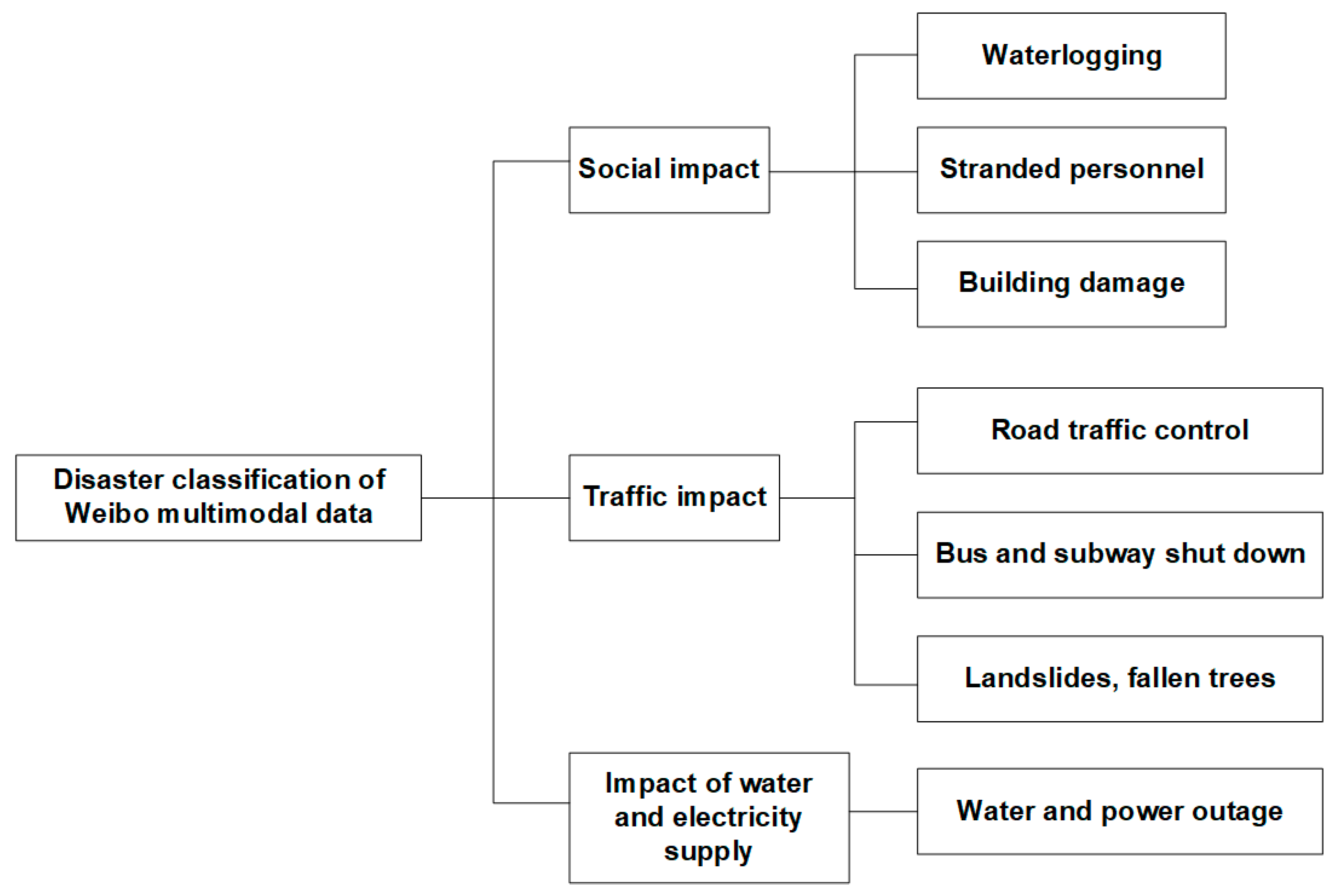
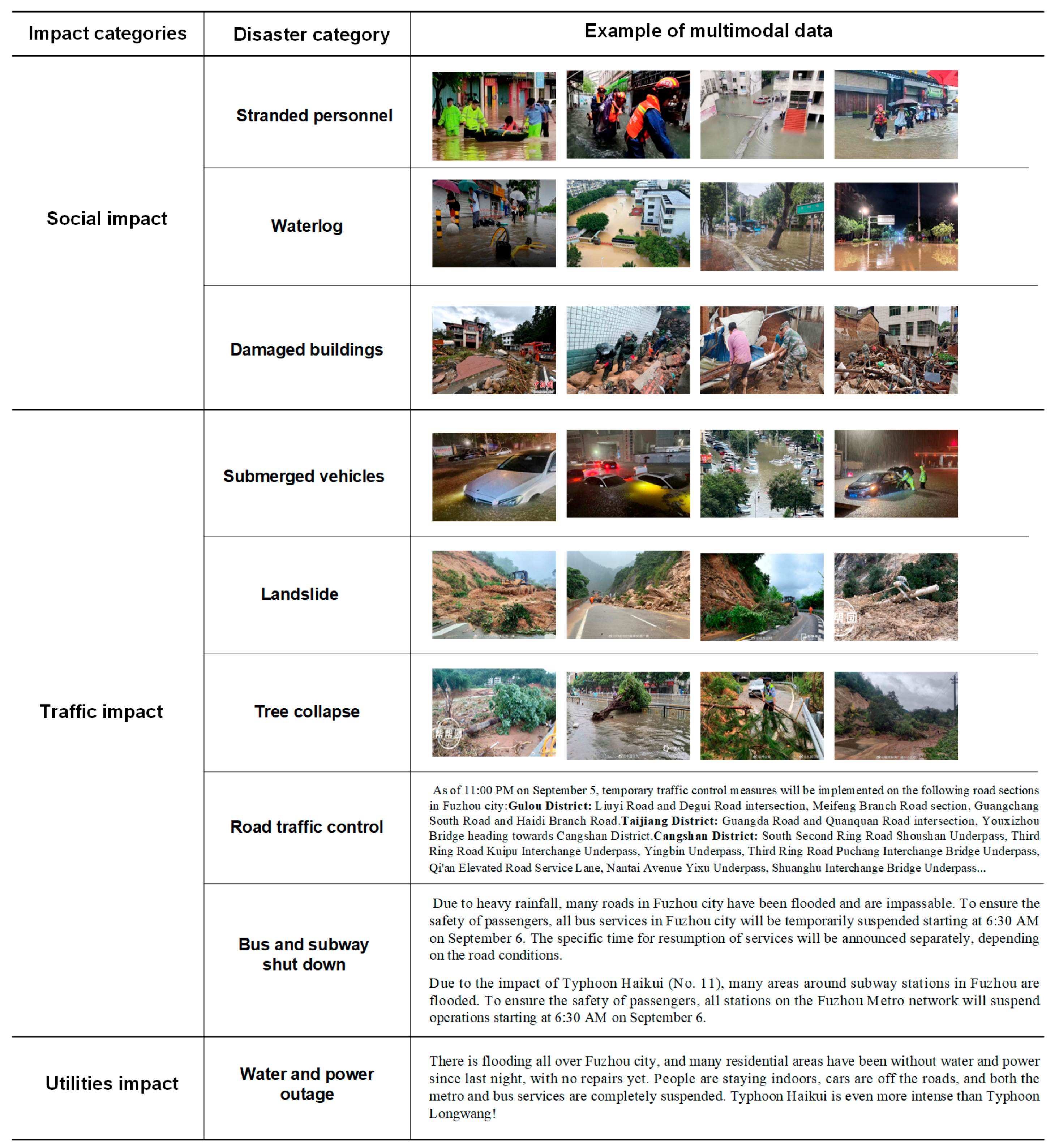
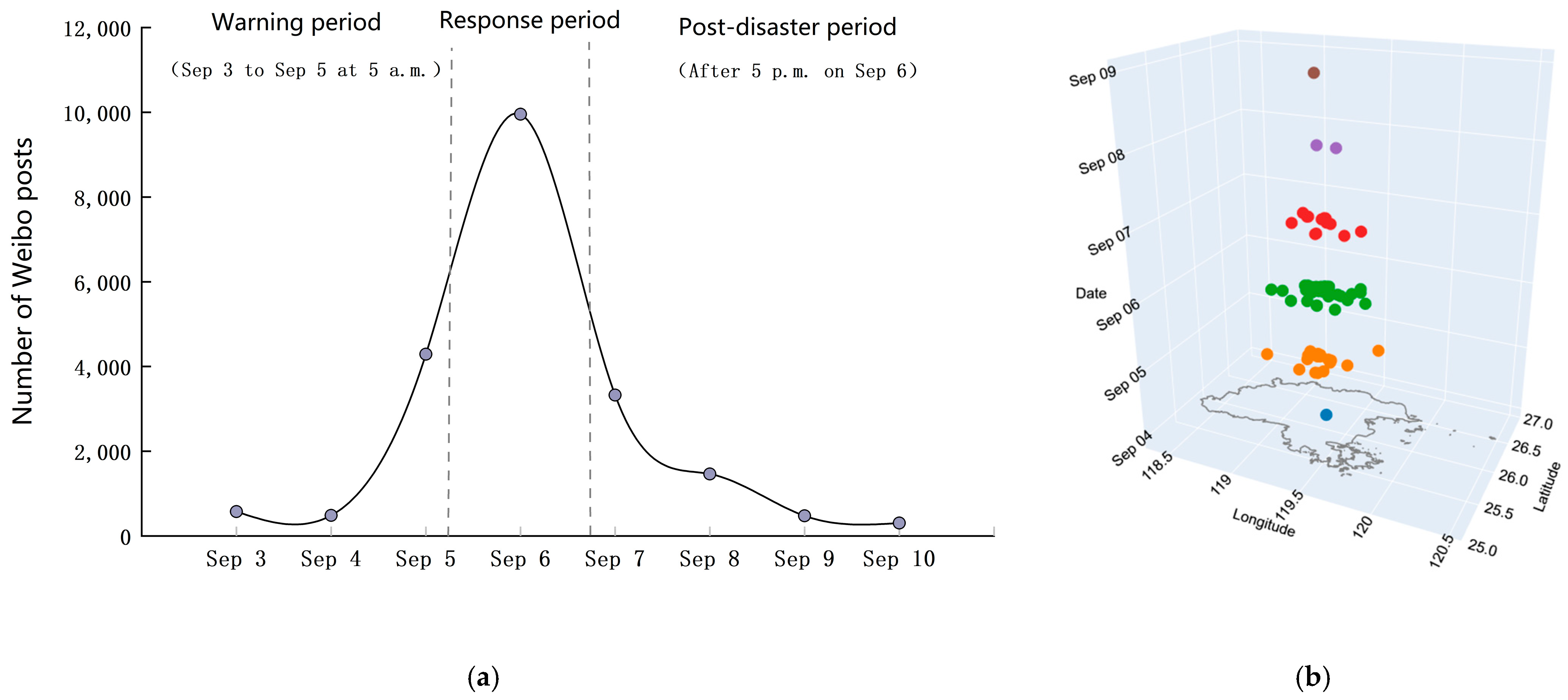

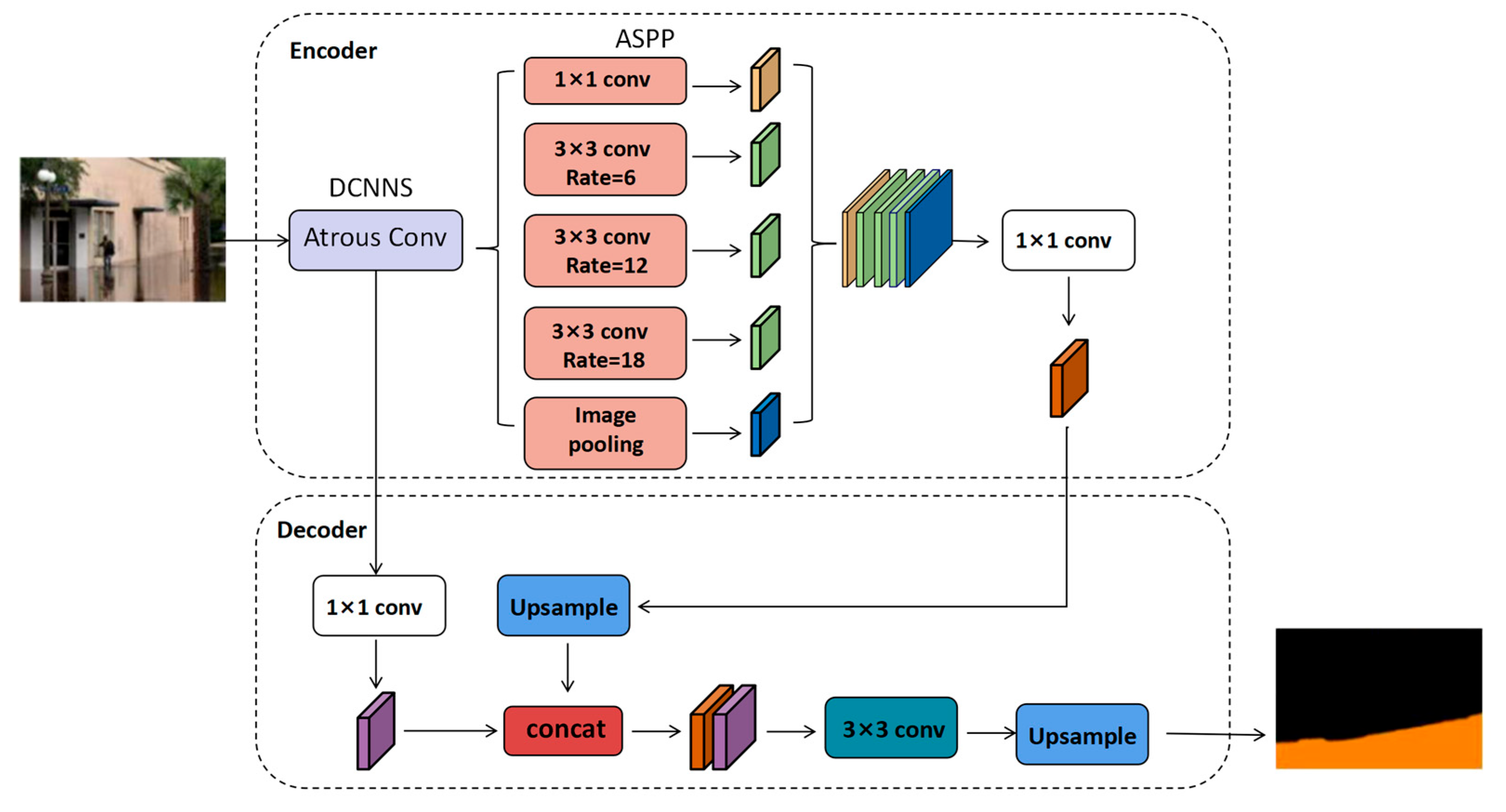
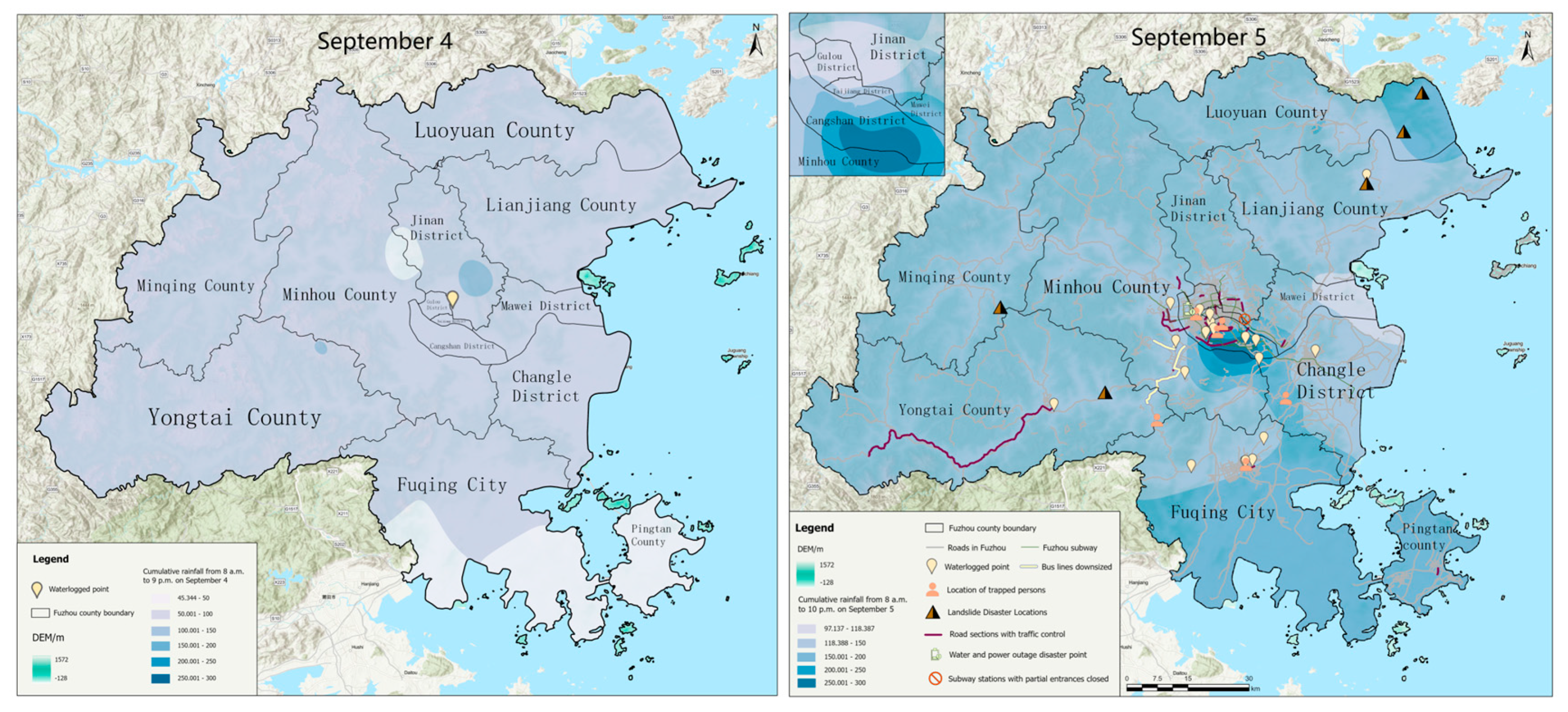
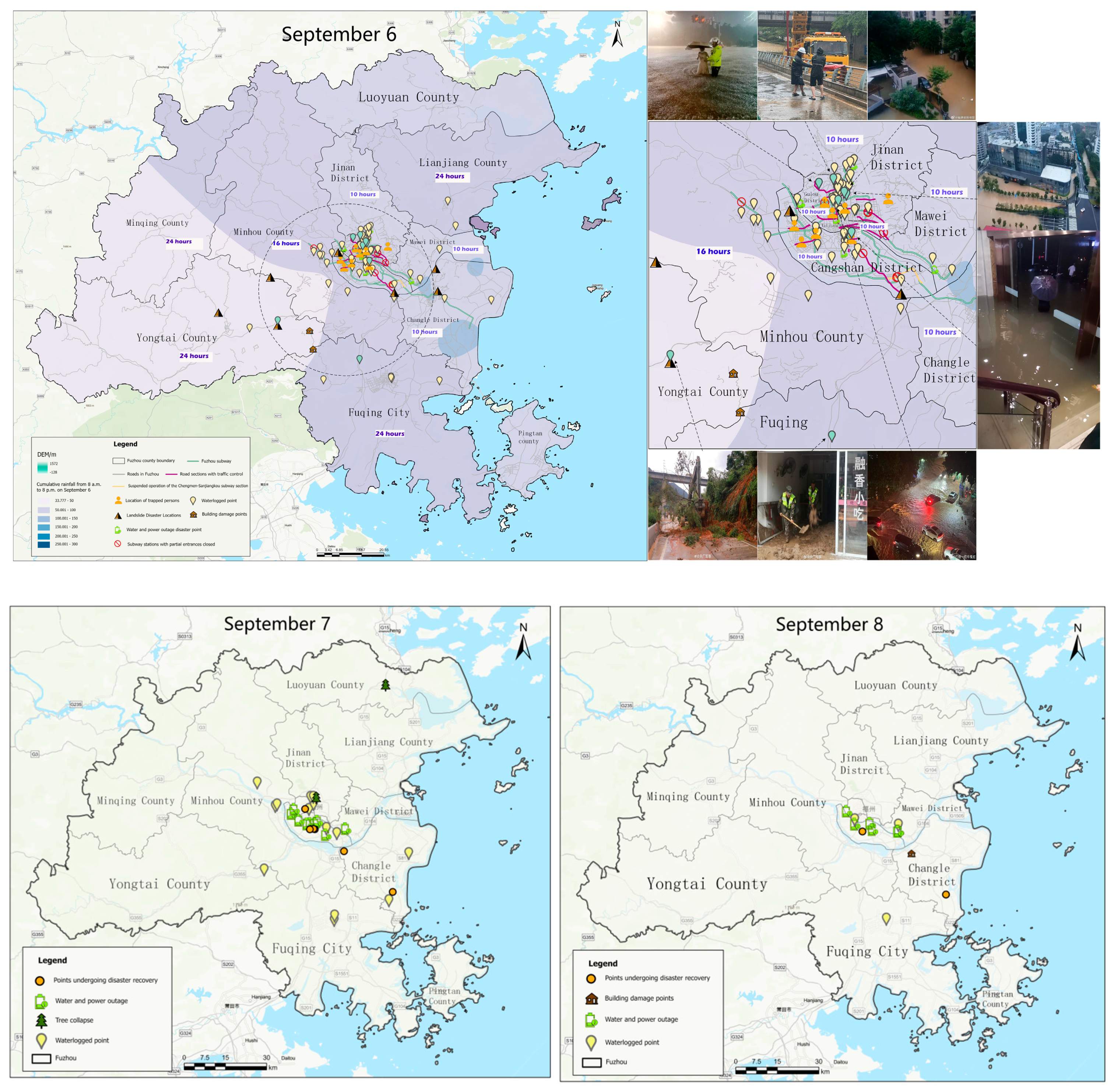
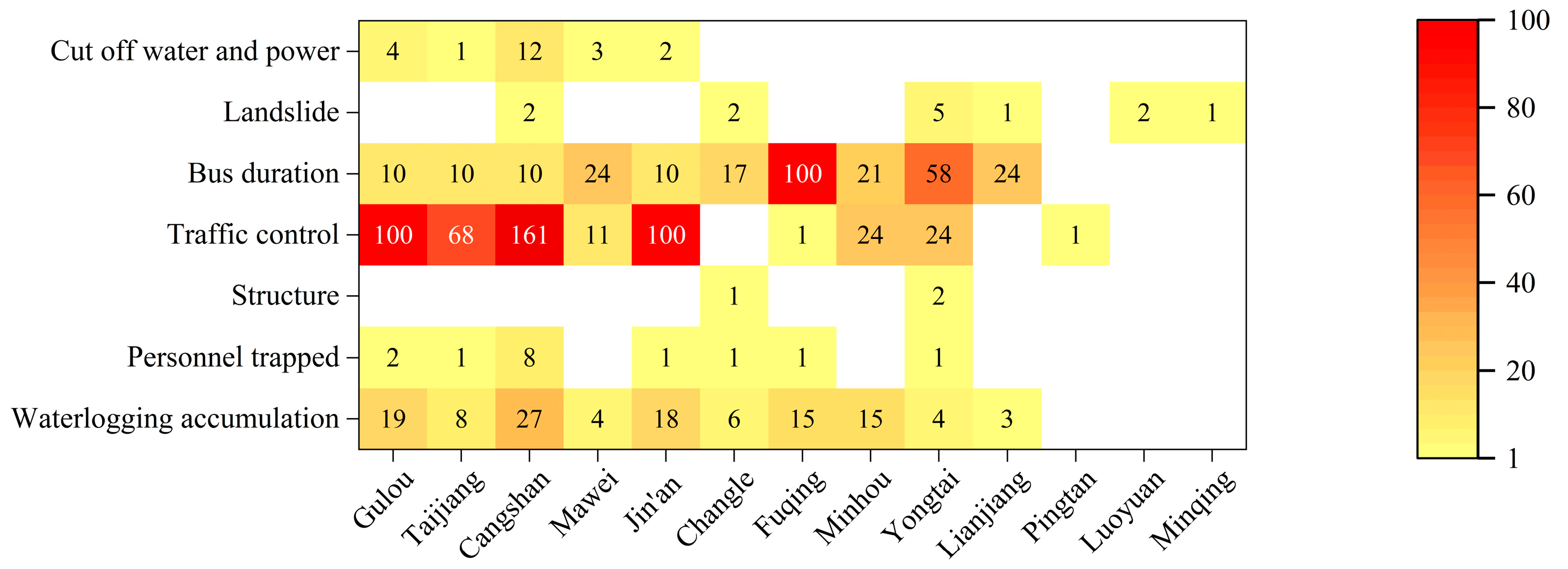

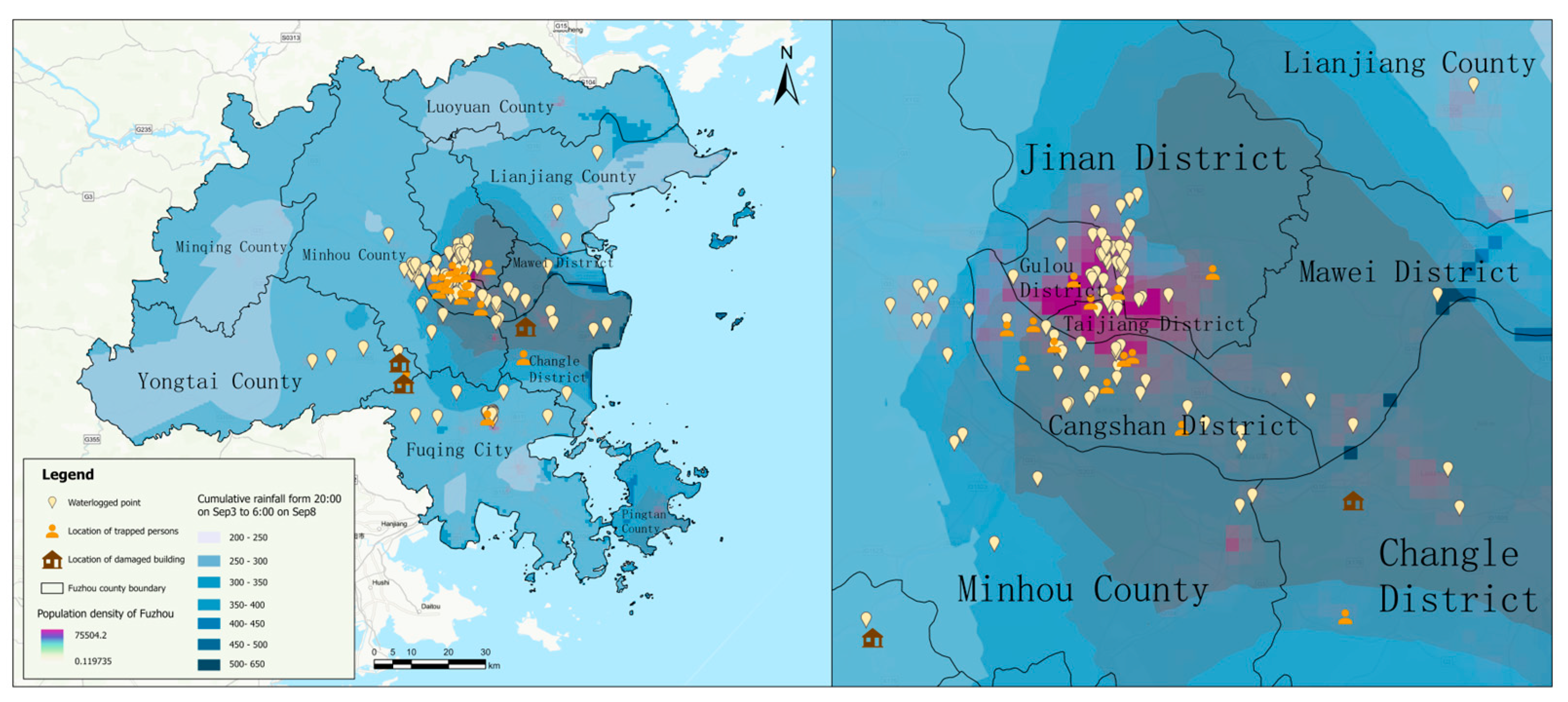

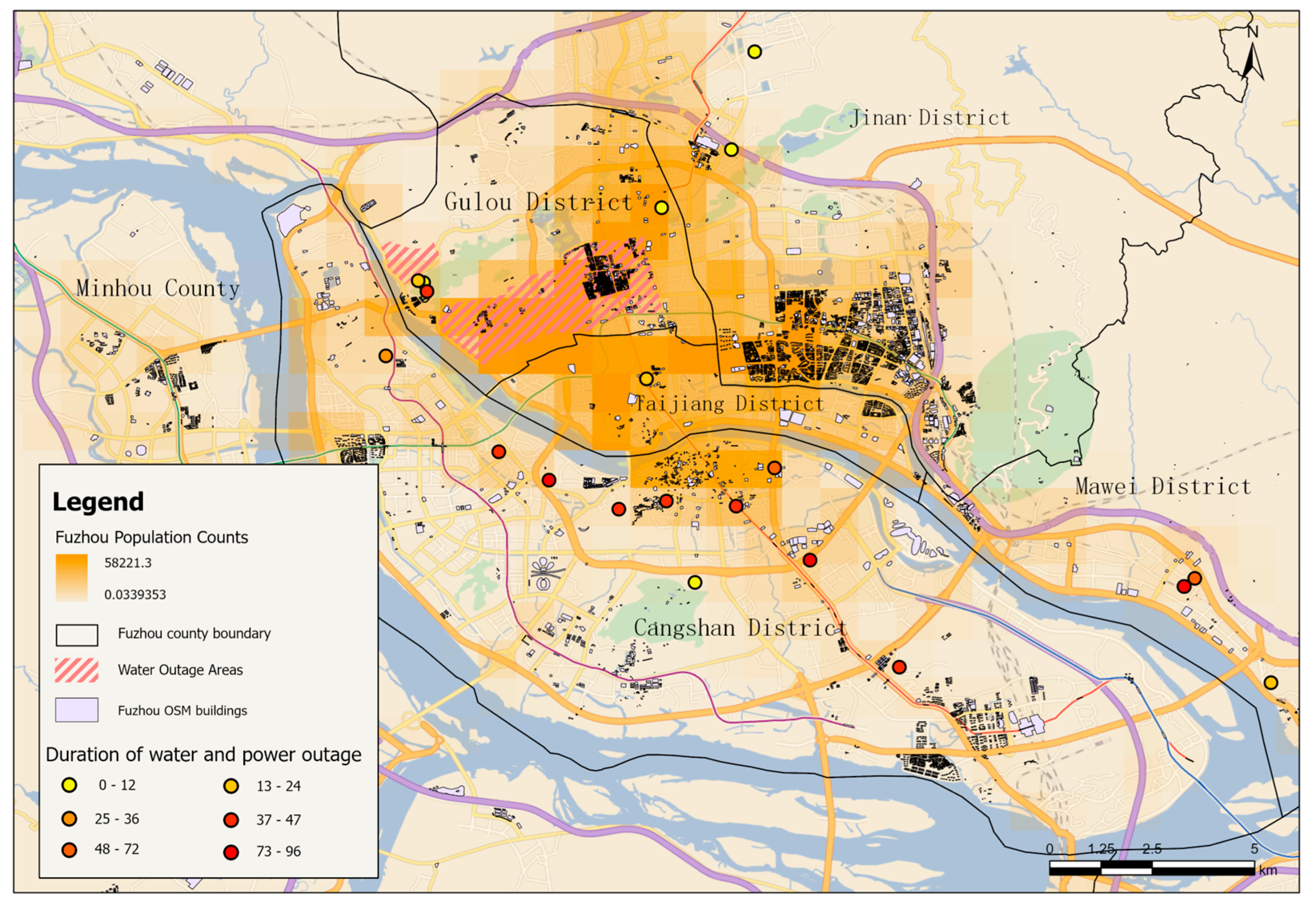

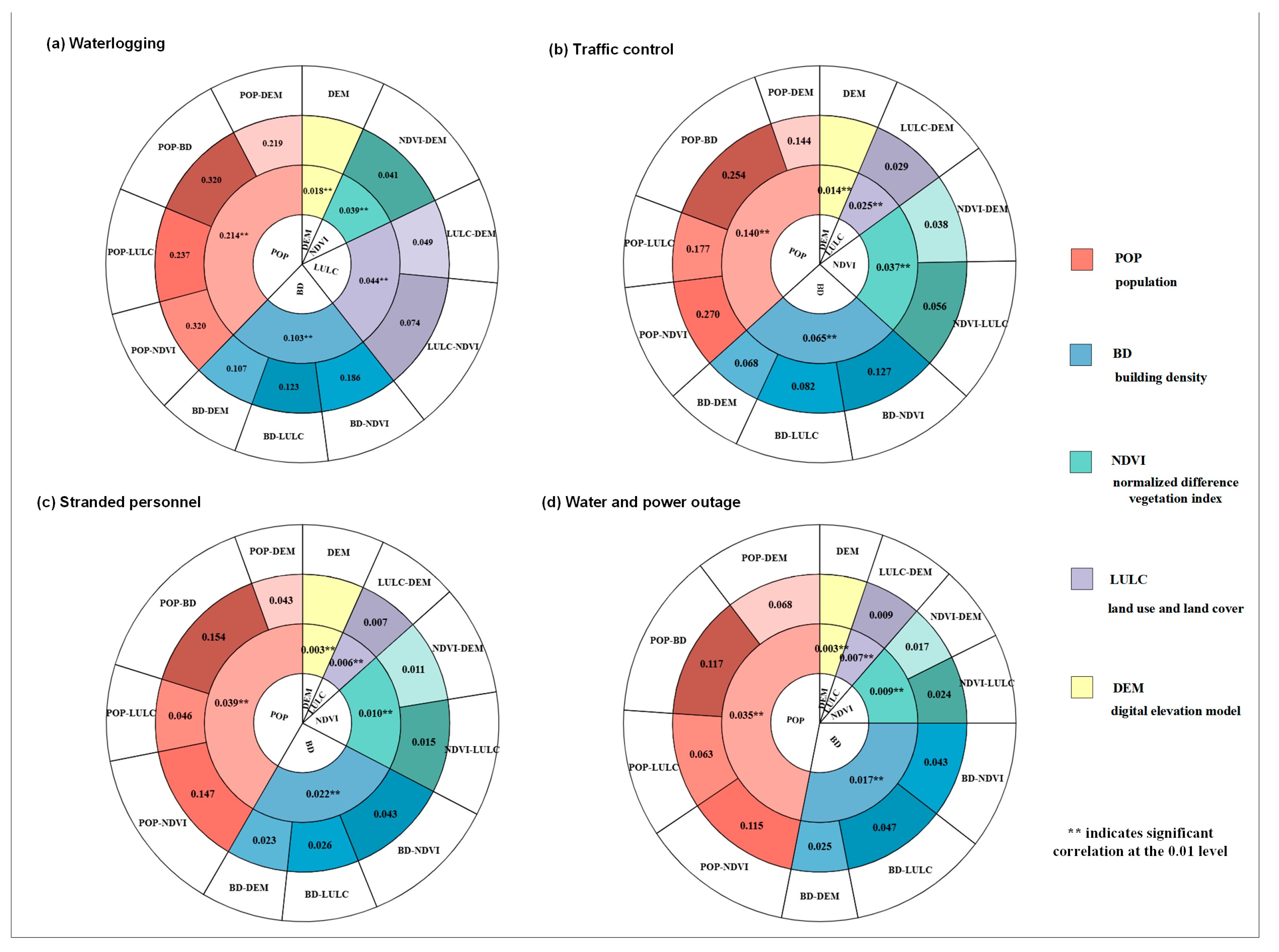
| Data | Dataset Category | Data sources |
|---|---|---|
| Disaster damage correlation image data | Train and test dataset | ⟪Typhoon disaster monitoring dataset in Hainan based on social media⟫ [41] |
| Validation dataset | Weibo images during Typhoon Haikui | |
| Disaster Segmentation Image Data | Train and test dataset | Screening and Annotation of Deep Learning Benchmarks and Datasets for Social Media Image Classification for Disaster Response [39] and Weibo Images Related to Disaster Damage in Typhoon Siempa 2022 |
| Validation dataset | Images of damage during Typhoon Haikui | |
| Text data | Validation dataset | Texts corresponding to images during Typhoon Haikui 2023 |
| Typhoon data | From the typhoon website of the National Meteorological Center, including the start and end time, latitude and longitude, typhoon grade, wind speed, pressure, moving direction, and moving speed of Typhoon Haikui No. 11 in 2023 |
| Cumulative rainfall data | Sourced from Weibo images, kriging interpolation of rainfall fields after geocoding of observation stations |
| Road data | OpenstreetMap website |
| Bus and subway data | Use the Python package TransBigData to obtain traffic space-time big data |
Disclaimer/Publisher’s Note: The statements, opinions and data contained in all publications are solely those of the individual author(s) and contributor(s) and not of MDPI and/or the editor(s). MDPI and/or the editor(s) disclaim responsibility for any injury to people or property resulting from any ideas, methods, instructions or products referred to in the content. |
© 2025 by the authors. Licensee MDPI, Basel, Switzerland. This article is an open access article distributed under the terms and conditions of the Creative Commons Attribution (CC BY) license (https://creativecommons.org/licenses/by/4.0/).
Share and Cite
Gao, S.; Yang, T.; Xu, Y.; Mou, N.; Wang, X.; Huang, H. Enhancing Disaster Situation Awareness Through Multimodal Social Media Data: Evidence from Typhoon Haikui. Appl. Sci. 2025, 15, 465. https://doi.org/10.3390/app15010465
Gao S, Yang T, Xu Y, Mou N, Wang X, Huang H. Enhancing Disaster Situation Awareness Through Multimodal Social Media Data: Evidence from Typhoon Haikui. Applied Sciences. 2025; 15(1):465. https://doi.org/10.3390/app15010465
Chicago/Turabian StyleGao, Songfeng, Tengfei Yang, Yuning Xu, Naixia Mou, Xiaodong Wang, and Hao Huang. 2025. "Enhancing Disaster Situation Awareness Through Multimodal Social Media Data: Evidence from Typhoon Haikui" Applied Sciences 15, no. 1: 465. https://doi.org/10.3390/app15010465
APA StyleGao, S., Yang, T., Xu, Y., Mou, N., Wang, X., & Huang, H. (2025). Enhancing Disaster Situation Awareness Through Multimodal Social Media Data: Evidence from Typhoon Haikui. Applied Sciences, 15(1), 465. https://doi.org/10.3390/app15010465







